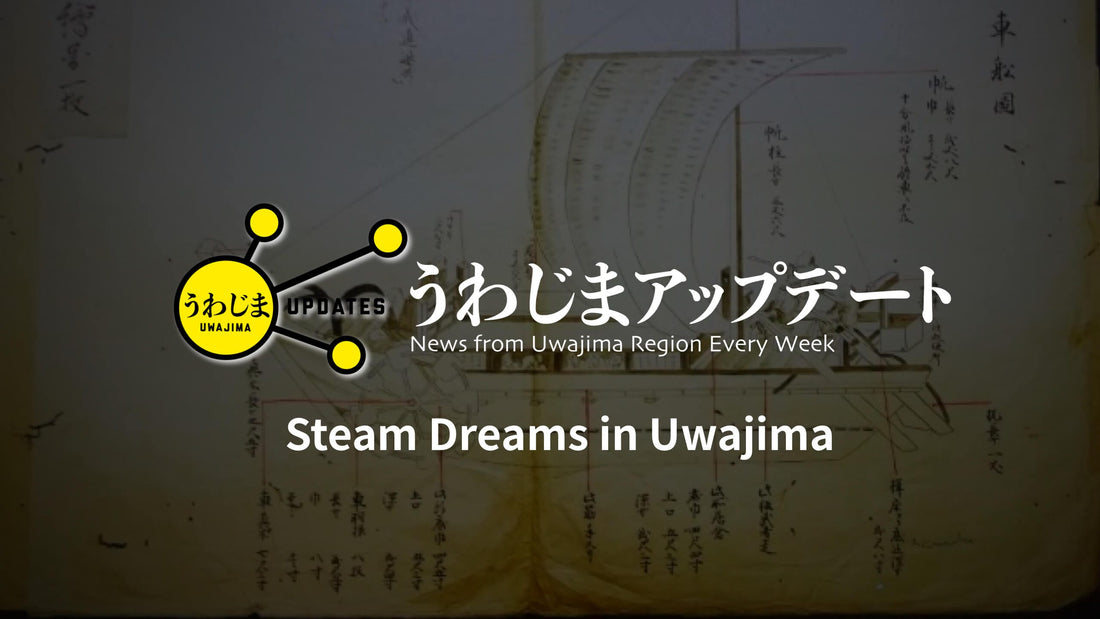
Uwajima Updates: Steam Dreams in Uwajima
Masaki SeikeShare
今回のテーマは「宇和島が見た"蒸気の夢"」。少しロマンチックな響きですが、実は宇和島の歴史に刻まれた本当のお話。
先日、東京で働く息子から「社員旅行が愛媛になった」と連絡がありました。社員旅行という言葉に昭和の懐かしさを感じながらも、まさか会社の仲間と一緒に地元へ帰ってくるとは。今さらながらおすすめの観光地を聞かれ、「そこはやっぱり宇和島やろ〜」と返しました。定番の宇和島城や伊達博物館、天赦園、そしておいしい海の幸を紹介しましたが、それだけでは少し物足りない。せっかくなら故郷で"何か"を見つけてほしいと思い、幕末に宇和島で活躍した細工職人・嘉蔵(かぞう)の物語を伝えました。


時は幕末。当時の宇和島第8代藩主・伊達宗城(だてむねなり)は、変革期に必要な新しい技術として蒸気船の建造を考えます。そこで白羽の矢が立ったのが嘉蔵。後に前原巧山(まえばらこうざん)と呼ばれることになる彼は、豪商・清家市郎左衛門から「藩が火輪船(蒸気船)の工夫のできる人物を探している」と誘われました。最初は無理だと断ったものの、あるアイデアを思いつき、この難題に挑戦を始めます。やがてその挑戦が藩に認められ、厳しい身分制度の時代に一介の町人から侍へと取り立てられました。
その後、嘉蔵は短期間に何度も長崎へ留学し、外国語の技術書を学びながら約10年にわたり試行錯誤を重ね、ついに日本人による初の国産蒸気船「火輪船」を完成させます。
これは単なる職人の技術だけでは成し得なかった成果です。殿様の広い視野、常識を超えて職人を侍に抜擢する決断、基礎技術を支えた地域の力──すべてがチームワークとなって実を結びました。
現代に生きる私たちにとっても同じですね。新しい技術は大切ですが、それだけでは未来を切り拓けません。実行力、忍耐、学び続ける姿勢も必要ですし、何より大切なのは世の中の流れを感じ取ること。「おのずと道は開ける」とよく言われますが、実際には自然に道ができるわけではありません。目の前にあるのは、道とも呼べないような危険で心もとない獣道。その痕跡を目標を持って何度も歩き続けることで、やがて一本の道へと形づくられていく…という感じでしょうか。

社員旅行で故郷・愛媛を訪れる機会が、息子にとっても会社の仲間にとっても、心に残る良い旅になりますように。
参考文献:
- 宇和島市指定 前原巧山の墓
https://www.city.uwajima.ehime.jp/site/sizen-bunka/119maebara.html - 【造船海運コラム】 #1 前原巧山~純国産の蒸気船は宇和島生まれ?~
https://miyoshishipbuilding.co.jp/2020/04/21/column01/ - モノづくり温故知新 第二話 「蒸気船を持ちたい」という殿様の命令でつくってしまった家具職人
https://ilink-corp.co.jp/1097.html
Uwajima Updates: Steam Dreams in Uwajima
This week’s theme is Steam Dreams in Uwajima. It may sound romantic, but it is in fact a true story deeply rooted in Uwajima’s history.
The other day, my son, who works in Tokyo, told me that his company’s staff trip would be heading to Ehime. The word “staff trip (社員旅行, shain-ryokou)” itself feels nostalgic to most people born in the Showa era, and I was surprised that he would return to his hometown together with his colleagues. He asked me for recommendations for good tourist spots, and I quickly replied, “It has to be Uwajima.” I mentioned the classics—Uwajima Castle, the Date Museum, Tenshaen Garden, and of course the well-known fresh seafood from the Nannyo (Southern Part of Ehime Pref.) area. But I wanted them to discover something more than just sightseeing. So, I shared with him the story of a craftsman named Kazō, who lived in Uwajima during the turbulent late Edo period.
At that time, the 8th lord of Uwajima, Date Munenari, recognized the need for new technology and ordered the construction of a steamship. Kazō, later known as Maehara Kozan, was introduced by a wealthy merchant, Ichirozaemon Seike, who told him that the domain was looking for someone capable of devising a steamship. Although he first declined, believing it impossible, he later conceived an idea and decided to take on the challenge. His efforts were recognized by the domain, and remarkably, in an age of rigid social hierarchy, he was elevated from commoner to samurai.
Kazō traveled repeatedly to Nagasaki, where he studied foreign technical texts and spent nearly ten years in trial and error. In the end, he succeeded in building Japan’s first domestically produced steamship known as the Karin-sen (“fire-wheel ship”).
This achievement was not the result of his craftsmanship alone. It was made possible by the lord’s broad vision, his bold decision to promote a craftsman to the samurai class, and the technical foundation supported by the local community. It was the product of teamwork, persistence, and foresight.
The lesson is no different today. Technology is important, but it alone cannot open the future. We also need execution, patience, and a willingness to keep learning. Most importantly, we must sense the flow of society around us. People often say, “The road opens naturally when we persist in the way we believe in.” Yet perhaps it is closer to the truth to say: what lies before us may look less like a road and more like a dangerous, barely visible trail. By walking it again and again with purpose, that uncertain path gradually becomes a true road.
I hope that this company trip to Ehime will be a memorable journey, not only for my son but also for his colleagues, giving them a chance to experience both the beauty and the dreams of Uwajima.
